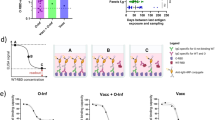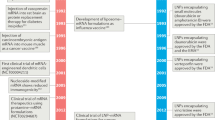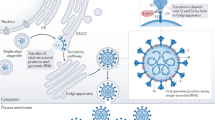Abstract
Toxoid vaccines—vaccines based on inactivated bacterial toxins—are routinely used to promote antitoxin immunity for the treatment and prevention of bacterial infections1,2,3,4. Following chemical or heat denaturation, inactivated toxins can be administered to mount toxin-specific immune responses. However, retaining faithful antigenic presentation while removing toxin virulence remains a major challenge and presents a trade-off between efficacy and safety in toxoid development. Here, we show a nanoparticle-based toxin-detainment strategy that safely delivers non-disrupted pore-forming toxins for immune processing. Using erythrocyte membrane-coated nanoparticles and staphylococcal α-haemolysin, we demonstrate effective virulence neutralization via spontaneous particle entrapment. Compared with vaccination with heat-denatured toxin, mice vaccinated with the nanoparticle-detained toxin showed superior protective immunity against toxin-mediated adverse effects. We find that the non-disruptive detoxification approach benefited the immunogenicity and efficacy of toxoid vaccines. We anticipate that this study will open new possibilities in the preparation of antitoxin vaccines against the many virulence factors that threaten public health.
This is a preview of subscription content, access via your institution
Access options
Subscribe to this journal
Receive 12 print issues and online access
$259.00 per year
only $21.58 per issue
Buy this article
- Purchase on Springer Link
- Instant access to full article PDF
Prices may be subject to local taxes which are calculated during checkout




Similar content being viewed by others
References
Kitchin, N. R. Review of diphtheria, tetanus and pertussis vaccines in clinical development. Exp. Rev. Vaccines 10, 605–615 (2011).
Greenberg, R. N., Marbury, T. C., Foglia, G. & Warny, M. Phase I dose finding studies of an adjuvanted Clostridium difficile toxoid vaccine. Vaccine 30, 2245–2249 (2012).
Mortimer, E. A. Jr. Immunization against infectious disease. Science 200, 902–907 (1978).
Holmgren, J. et al. Development of improved cholera vaccine based on subunit toxoid. Nature 269, 602–604 (1977).
Gentschev, I., Dietrich, G. & Goebel, W. The E. coli alpha-hemolysin secretion system and its use in vaccine development. Trends Microbiol. 10, 39–45 (2002).
Cover, T. L. & Blanke, S. R. Helicobacter pylori VacA, a paradigm for toxin multifunctionality. Nature Rev. Microbiol. 3, 320–332 (2005).
Bubeck Wardenburg, J. & Schneewind, O. Vaccine protection against Staphylococcus aureus pneumonia. J. Exp. Med. 205, 287–294 (2008).
Parish, H. J. & Cannon, D. A. Staphylococcal infection: antitoxic immunity. Br. Med. J. 1, 743–747 (1960).
Metz, B. et al. Identification of formaldehyde-induced modifications in proteins: reactions with model peptides. J. Biol. Chem. 279, 6235–6243 (2004).
Cryz, S. J. Jr, Furer, E. & Germanier, R. Effect of chemical and heat inactivation on the antigenicity and immunogenicity of Vibrio cholerae. Infect. Immunol. 38, 21–26 (1982).
Vogel, F. R. Improving vaccine performance with adjuvants. Clin. Infect. Dis. 30(Suppl 3), S266–S270 (2000).
Kennedy, A. D. et al. Targeting of alpha-hemolysin by active or passive immunization decreases severity of USA300 skin infection in a mouse model. J. Infect. Dis. 202, 1050–1058 (2010).
Adhikari, R. P. et al. Novel structurally designed vaccine for S. aureus α-hemolysin: protection against bacteremia and pneumonia. PLoS One 7, e38567 (2012).
Jang, S. I. et al. Vaccination with Clostridium perfringens recombinant proteins in combination with Montanide ISA 71 VG adjuvant increases protection against experimental necrotic enteritis in commercial broiler chickens. Vaccine 30, 5401–5406 (2012).
Kirkham, L. A. et al. Construction and immunological characterization of a novel nontoxic protective pneumolysin mutant for use in future pneumococcal vaccines. Infect. Immunol. 74, 586–593 (2006).
Hu, C. M. et al. Erythrocyte membrane-camouflaged polymeric nanoparticles as a biomimetic delivery platform. Proc. Natl Acad. Sci. USA 108, 10980–10985 (2011).
Hu, C. M., Fang, R., Copp, J., Luk, B. & Zhang, L. A biomimetic nanosponge that absorbs pore-forming toxins. Nature Nanotech. 8, 336–340 (2013).
Dobrovolskaia, M. A. & McNeil, S. E. Immunological properties of engineered nanomaterials. Nature Nanotech. 2, 469–478 (2007).
Moon, J. J. et al. Interbilayer-crosslinked multilamellar vesicles as synthetic vaccines for potent humoral and cellular immune responses. Nature Mater. 10, 243–251 (2011).
Sun, C. et al. Circumventing anti-vector immunity using adenovirus-infected blood cells for repeated application of adenovirus vectored vaccines: proof-of-concept in rhesus macaques. J. Virol. 86, 11031–11042 (2012).
Roberts, D. M. et al. Hexon-chimaeric adenovirus serotype 5 vectors circumvent pre-existing anti-vector immunity. Nature 441, 239–243 (2006).
Skean, J. D. & Overcast, W. W. Efficacy of staphylococcal vaccines to elicit antistaphylococcal alpha-hemolysin in dairy cows. J. Dairy Sci. 51, 1239–1242 (1968).
Elamanchili, P., Diwan, M., Cao, M. & Samuel, J. Characterization of poly(D,L-lactic-co-glycolic acid) based nanoparticulate system for enhanced delivery of antigens to dendritic cells. Vaccine 22, 2406–2412 (2004).
Moon, J. J. et al. Enhancing humoral responses to a malaria antigen with nanoparticle vaccines that expand Tfh cells and promote germinal center induction. Proc. Natl Acad. Sci. USA 109, 1080–1085 (2012).
Inoshima, I. et al. A Staphylococcus aureus pore-forming toxin subverts the activity of ADAM10 to cause lethal infection in mice. Nature Med. 17, 1310–1314 (2011).
Moon, J. J., Huang, B. & Irvine, D. J. Engineering nano- and microparticles to tune immunity. Adv. Mater. 24, 3724–3746 (2012).
Swartz, M. A., Hirosue, S. & Hubbell, J. A. Engineering approaches to immunotherapy. Sci. Transl. Med. 4, 148rv149 (2012).
Reddy, S. T. et al. Exploiting lymphatic transport and complement activation in nanoparticle vaccines. Nature Biotechnol. 25, 1159–1164 (2007).
Hubbell, J. A., Thomas, S. N. & Swartz, M. A. Materials engineering for immunomodulation. Nature 462, 449–460 (2009).
Parodi, A. et al. Synthetic nanoparticles functionalized with biomimetic leukocyte membranes possess cell-like functions. Nature Nanotech. 8, 61–68 (2013).
Acknowledgements
This work was supported by the National Institute of Diabetes and Digestive and Kidney Diseases of the National Institutes of Health (award no. R01DK095168) and by the National Science Foundation (grant DMR-1216461). B.L. is supported by a National Institutes of Health training grant (R25CA153915) from the National Cancer Institute.
Author information
Authors and Affiliations
Contributions
L.Z. conceived and designed the experiments with C-M.H., R.F. and B.L. Experiments were performed by C-M.H., R.F. and B.L. All authors analysed and discussed the data and wrote the manuscript.
Corresponding author
Ethics declarations
Competing interests
The authors declare no competing financial interests.
Supplementary information
Supplementary information
Supplementary Information (PDF 4796 kb)
Rights and permissions
About this article
Cite this article
Hu, CM., Fang, R., Luk, B. et al. Nanoparticle-detained toxins for safe and effective vaccination. Nature Nanotech 8, 933–938 (2013). https://doi.org/10.1038/nnano.2013.254
Received:
Accepted:
Published:
Issue Date:
DOI: https://doi.org/10.1038/nnano.2013.254
This article is cited by
-
Microbial synthesis of Prussian blue for potentiating checkpoint blockade immunotherapy
Nature Communications (2023)
-
Story of Pore-Forming Proteins from Deadly Disease-Causing Agents to Modern Applications with Evolutionary Significance
Molecular Biotechnology (2023)
-
Minimizing adverse effects of Cerenkov radiation induced photodynamic therapy with transformable photosensitizer-loaded nanovesicles
Journal of Nanobiotechnology (2022)
-
T lymphocyte membrane-decorated epigenetic nanoinducer of interferons for cancer immunotherapy
Nature Nanotechnology (2021)
-
Vaccination against pathogenic clostridia in animals: a review
Tropical Animal Health and Production (2021)



